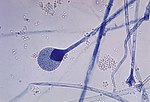Mucorales
| Den här artikeln har skapats av Lsjbot, ett program (en robot) för automatisk redigering. (2012-10) Artikeln kan innehålla fakta- eller språkfel, eller ett märkligt urval av fakta, källor eller bilder. Mallen kan avlägsnas efter en kontroll av innehållet (vidare information) |
| Mucorales | |
(c) James Lindsey at Ecology of Commanster, CC BY-SA 3.0 | |
| Systematik | |
|---|---|
| Domän | Eukaryoter Eukaryota |
| Rike | Svampar Fungi |
| Division | Oksvampar Zygomycota |
| Ordning | Mucorales |
| Vetenskapligt namn | |
| § Mucorales | |
Mucorales är en ordning av svampar. Enligt Catalogue of Life[1] ingår Mucorales i divisionen oksvampar och riket svampar,[1] men enligt Dyntaxa[2] är tillhörigheten istället klassen Zygomycetes, divisionen oksvampar och riket svampar.[2]
| oksvampar |
| ||||||||||||||||||||||||||||||||||||||||||||||||||||||||||||||||||||||||||||||
Källor
- ^ [a b] Bisby F.A., Roskov Y.R., Orrell T.M., Nicolson D., Paglinawan L.E., Bailly N., Kirk P.M., Bourgoin T., Baillargeon G., Ouvrard D. (red.) (10 augusti 2011). ”Species 2000 & ITIS Catalogue of Life: 2011 Annual Checklist.”. Species 2000: Reading, UK. http://www.catalogueoflife.org/annual-checklist/2011/search/all/key/mucorales/match/1. Läst 24 september 2012.
- ^ [a b] Dyntaxa Mucorales
- (c) James Lindsey at Ecology of Commanster, CC BY-SA 3.0
Media som används på denna webbplats
Robot icon
(c) James Lindsey at Ecology of Commanster, CC BY-SA 3.0
Mucor mucedo. from Commanster, Belgium.
The determination of the species shown in this picture has been verified.Författare/Upphovsman: Nephron, Licens: CC BY-SA 3.0
Micrograph of zygomycosis (also mucormycosis - more specific). Lung biopsy.
Mucor forms hyphae with variable thickness when within tissue, unlike Aspergillus (which have a uniform thickness) and branch at 45 degrees.
Zygomycosis is often found in association with diabetes mellitus and immunodeficiency/dysfunction.
See also
This photomicrograph reveals a mature sporangium of a Absidia sp. fungus. Mucor is a common indoor mold, and is among the fungi that cause the group of infections known as zygomycosis. The infection typically involves the rhino-facial-cranial area, lungs, GI tract, skin, or less commonly other organ systems.










